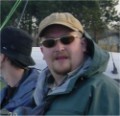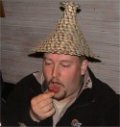The Tying
Right then, to business! This is not an article on flytying methods as such, so this chapter will be concerned with giving some hints and tips on how to speed up your tying and how to incorporate some routines that make life as a production flytyer easier.
A.K. Best, one of the best-known production flytyers ties so many flies a year that I dare not think about it, but he once said that you'll have a tie 10 dozen of the same fly to be completely familiar with the pattern. And although there is some truth in that, I find I can quickly familiarize myself with a specific pattern by tying the first 2 or 3 very slowly and carefully considering the order of the tying. This is especially important when confronted with an order of flies that you've never tied before. He also has another really important peice of advice - don't take the time to marvel over your creations. *Know* that the tinsel is fine on the other side of the shank as well, don't look. Keep tying :-)
I study the pattern closely, tie a couple of trial-flies for the above reason and to judge the materials needed: length of hackle, amount of dubbing on each fly or the wing profile all the things that must be studied to tie proper looking and consistent flies. Most importantly, I study the tying itself, meaning looking for shortcuts and making sure that I don't run up and down the hook-shank with the thread unless it's absolutely necessary.
Once I'm comfortable with all aspects of the fly, the tying, the materials and the proportion, I pre-cut, pluck and arrange the materials and then tie, tie-tie-tie-tie until I'm done.
When building the head of the fly, try to use the whip-finish to make the last turns on the head; it saves time and bulk leading to neater flies.
I find that it doesn't save time to varnish the fly in the vice just as it's done. Instead I put them all on the table (or preferably in a container) and then varnish the all heads at once. That saves time for two reasons: [1] I only have to open the bottle of varnish once (an open bottle of varnish amongst your materials is bound to cause disaster at some point) and [2] I don't have to change between needle and scissors, again saving time.
One of the most important things I've learned is that you should cut as many of the materials as possible before they go on the hook. Cutting say hairwings on the shank is time-consuming, as you will need several snips to clean it up properly and this goes for most materials. Cutting off the hook gives you a clean edge in one snip and with a little practice and a good Pinch-and-Loop, you can tie down anything with very little materials protruding from the wraps of thread. When tying in hackles, clean the feather for fluff and cut the stem to the length needed to secure it to the hook don't leave a long tag that needs to be cut after it's been tied in. This also goes for tinsels, ribbing and other materials. Observing this will often lead to better looking flies as well.
Knowing how your thread behaves also makes a huge difference. Often, when tying a body you'll want the thread to lay flat on the shank, giving as little bulk as possible and you do this by counter-twisting the thread. On the other hand, a flat thread is a little weaker than a twisted one, so when you tie down a hairwing, for instance, it's a good idea to slightly twist the thread again, making it stronger and also allowing it to bite down slightly better on the material.
Another small tip is to, whenever possible, use the tying-thread for rib. For example when tying say a palmered wet, a good idea would be to tie the palmer hackle in at the eye. Dub the thread for the body at the eye as well, dubbing backwards towards the bend and palmer the hackle backwards. Catch the hackle with the tying thread and counter rib up over the body securing both body and hackle in the same process.
There are of course billions of little tricks like these, and I can't mention them all, but as you go along, exploring the discipline, they will reveal themselves if you give a little thought.
The hallmark of a good production flytyer is consistency each fly must look exactly like the previous one.
The Patterns
If you're considering beginning a production maybe selling to your local flyshop there are some important issues to consider when you decide which patterns to offer. You must be careful when you create your selection. Tying too complicated flies will make life harder for the production tier. Often, people are slow to recognize the time going into complicated patterns and are hence reluctant to pay the price they should.
When pricing your selection, make sure you think it's worth the effort. It's a fine line too expensive and you'll only sell a few, too cheap and it won't be worth your effort. You must know how many of the different patterns you can tie per hour in order to set the right price. Once you know how many you can tie, you need to consider material costs and then finally decide on the how much you want per hour for your time. From then on it's simple mathematics. Make sure that you set the number of flies per hour slightly low, since you won't be able to concentrate hard on tying all the time. Regarding price, you can be as bold as you like, the market is yours. It's up to anyone to decline your offers. Again, lowering your price a little can give you more business, but as I said, it's fine line.
If you decide to tie to order, you won't have the luxury of selecting your patterns. That means you must have a good feeling for your own skills in order to price up an order. Again, you must judge the number of flies you can tie per hour and material costs and hook costs. And remember that an order for 2 flies of each type is killing... finding new materials all the time is very time-consuming.
Remember finally, that a high price must reflect the best materials and high-quality tying.
And remember to take breaks. I often tie for an hour or 50 minutes and then rest for 10. Otherwise, it becomes difficult to stay concentrated for longer periods of time. And as you can see on the picture below, production tying is serious business that requires concentration :-)))

Lars Chr. Bentsen
"Viking" Lars larscb@mail1.stofanet.dk is an archeologist and EFFF instructor. An amazing flytyer and part of last year's Denmark or Bust team, he believes that flycasting should be an adventure.













